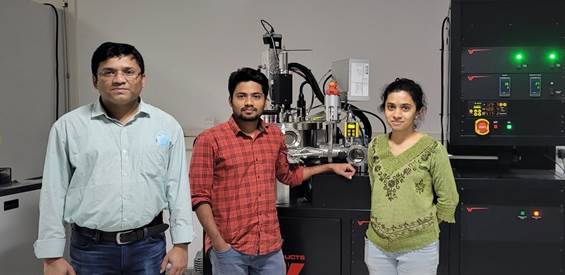Scientists discover key material for defence use, green energy

Photo credit PIB
By Our Special Correspondent
New Delhi, July 5: At a time when India is aiming big to tap solar power to cut dependence on fossil fuels, Bengaluru-based scientists have discovered a key material, which may make significant changes in the near future.
Scientists at Bengaluru’s Jawaharlal Nehru Centre for Advanced Scientific Research (JNCASR), an autonomous institute of Department of Science and Technology (DST), have discovered a novel material called single-crystalline scandium nitride (ScN) that can emit, detect, and modulate infrared light with high efficiencies.
The JNCASR scientists claimed that the material can be useful for solar and thermal energy harvesting and for optical communication devices.
It must be underlined that electromagnetic waves are a renewable energy source used for electricity generation, telecommunication, defence and security technologies, sensors, and healthcare services.
Scientists use high-tech methods to manipulate such waves precisely in dimensions that are thousands of times smaller than the human hair, using specialized materials.
However, not all the wavelengths of light (electromagnetic waves) are easy to utilize, especially infrared light, since it is difficult to detect and modulate.
For infrared light applications, intelligent and cutting-edge materials are required which can enable excitation, modulation, and detection at desired spectral range with high efficiencies. Only a few existing materials can serve as hosts for light-matter interactions in the infrared spectral range, albeit with very low efficiencies.
The operational spectral range of such materials also does not cover industrially important short wavelength infrared (SWIR) spectral range.
Researchers at the Centre utilized a scientific phenomenon called polariton excitations that occur in tailored materials when light couples with either the collective free electron oscillations or polar lattice vibrations to achieve this feat.
“They have carefully controlled material properties to excite polaritons (a quasi-particle) and achieve strong light-matter interactions in single-crystalline scandium nitride (ScN) using infrared light,” said the Ministry of Science and Technology in an official statement.
These exotic polaritons in the ScN can be utilized for solar and thermal energy harvesting.
Also, belonging to the same family of materials as gallium nitride (GaN), scandium nitride is compatible with modern complementary-metal-oxide-semiconductor (CMOS) or Si-chip technology, and, therefore, could be easily integrated for on-chip optical communication devices, added the Ministry.
“From electronics-to-healthcare, defense and security-to-energy technologies, there is a great demand for infrared sources, emitters and sensors. Our work on infrared polaritons in scandium nitride will enable its applications in many such devices,” said Dr. Bivas Saha, Assistant Professor at JNCASR.
Apart from JNCASR, researchers from the Centre for Nano Science and Engineering from the Indian Institute of Science (IISc.) and the University of Sydney also participated in this study published recently in the scientific journal Nano Letters.
India has laid out an ambitious plan to address climate change.
Prime Minister Narendra Modi at the recent COP26 meeting held in Glasgow presented the Panchamrit plan, India’s five-point climate action agenda, which included 500GW solar energy production by 2030, 50 per cent of its energy requirements from renewable energy by 2030, reduction of total projected carbon emissions by one billion tonnes from now to 2030, reduction of the carbon intensity of the economy by 45 per cent by 2030, over 2005 levels and achieving the target of net zero emissions by 2070.








